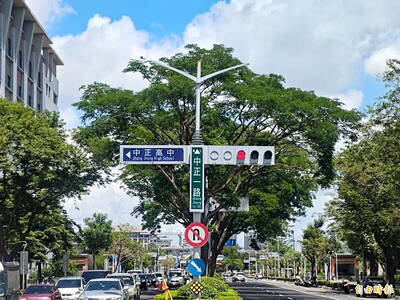Mobile games are thriving as players turn to them for fun and friendship during the pandemic, with increasing numbers of women joining the trend.
“Being stuck at home has not stopped people from playing games on their phones,” said SensorTower mobile insights strategist Craig Chapple. “To the contrary, mobile gaming is more popular than ever.”
Smartphone game play involves taps on touchscreens with just a few moments of play at a time, often while sipping coffee or waiting for transit, in contrast to the console games with immersive worlds that can span hours.

Photo: REUTERS
Mobile games appeal to a broader demographic than do shooters and other genres popular on console or PC gamers. More than 40 percent of mobile gamers are women, according to research firms Newzoo and Statista. That differs from gamers using consoles or personal computers, who are more likely to be males age 12 to 35 years old, according to analysts.
“We’ve had loads of people forced inside during lock-downs in need of entertainment,” said Futuresource mobile tech and gaming research analyst Morris Garrard. “Gaming being one of the most interactive and engaging forms of entertainment has seen a significant boost.”
According to the mobile consultancy App Annie, spending on mobile gaming is expected to see strong growth this year and top US$100 billion. Popular titles include Candy Crush Saga, Honor of Kings, Pokemon Go and Gardenscapes.
MINNOWS AND WHALES
Many mobile games are free to download and rely on massive numbers of people spending a little on things like extra lives, virtual outfits or items that boost in-game abilities. And, paying a dollar or so to upgrade to an ad-free version of a mobile game is seen by some as a bargain.
Mobile players who spend little to nothing are referred to in the industry as “minnows,” while those more willing to pay are “dolphins” of “whales” depending on how deep they reach into their wallets.
Casual games which rely on short play times such as puzzle and arcade-style games are among the most downloaded mobile titles.
A major innovation in recent years has been a “battle pass” system popularized by Fortnite from Epic Games, with players pay for tickets to each “season,” according to Chapple.
ADDICTIVE FUN?
Mobile game makers, like their console-focused peers, manipulate psychological levers that emotionally reward players and keep them engaged in ways that some say can be addictive.
The WHO has classified “gaming disorder” a disease characterized by “impaired control over gaming, increasing priority given to gaming over other activities” even if it is detrimental to one’s life.
But, in a stressful world, mobile games can be a relaxing escape while standing in queues, waiting for a food order or just whiling away time, according to players.
Playing mobile games can improve moods, boost brain power and provide a sense of community, according to proponents.
“Allocating a bit of time to playing games can improve your mental health in a lot of amazing ways,” Lifehack digital marketer Zuhair Sharif said in a blog. “This has led many to incorporate video games into their regular lives.”
Mobile game lovers are quick to point out that playing console or computer games in planes, buses or cars is not an option, while smartphones can be whipped out anywhere to make a few moves.
MOBILE MILLENIALS
Worldwide, an estimated 72 percent of active mobile game players are “millennials” ranging in age from 23 to 38 years old.
The broader audience for mobile games includes those in parts of the world where smartphones are the primary, if not only, way people connect to the internet
“In emerging regions, particularly China and India, it is absolutely huge,” Garrard said.
Mobile game revenue is powered by the fact that they are easily available to the more than four billion people in the world with smartphones, according to Garrard.
“Maybe they’re not spending a lot, but there are many who spend a little bit on mobile games and it really adds up,” Garrard said.
A trend toward cloud streaming services will likely boost mobile gaming, as titles once limited to consoles will be able to offer more play on smartphones or tablets since action is power by datacenters.
High-capacity, super-fast 5G telecom networks could enable game makers to bring console quality graphics and action to mobile devices, appealing to more hardcore players.
“The concept of gaming on the go will be ever more present, supported by improvements in mobile infrastructure,” Garrard said. “It’s not just the gaming platform will be benefiting, but the likes of kind of Google and Apple.”
Apple and Google are behind the mobile operating systems, iOS and Android respectively, that power nearly all of the world’s smartphones.
The US technology titans also run online shops for mobile apps, taking 30 percent commission on transactions in what has become a controversial toll given their dominance in the market.

June 9 to June 15 A photo of two men riding trendy high-wheel Penny-Farthing bicycles past a Qing Dynasty gate aptly captures the essence of Taipei in 1897 — a newly colonized city on the cusp of great change. The Japanese began making significant modifications to the cityscape in 1899, tearing down Qing-era structures, widening boulevards and installing Western-style infrastructure and buildings. The photographer, Minosuke Imamura, only spent a year in Taiwan as a cartographer for the governor-general’s office, but he left behind a treasure trove of 130 images showing life at the onset of Japanese rule, spanning July 1897 to

One of the most important gripes that Taiwanese have about the Democratic Progressive Party (DPP) is that it has failed to deliver concretely on higher wages, housing prices and other bread-and-butter issues. The parallel complaint is that the DPP cares only about glamor issues, such as removing markers of Chinese Nationalist Party (KMT) colonialism by renaming them, or what the KMT codes as “de-Sinification.” Once again, as a critical election looms, the DPP is presenting evidence for that charge. The KMT was quick to jump on the recent proposal of the Ministry of the Interior (MOI) to rename roads that symbolize

On the evening of June 1, Control Yuan Secretary-General Lee Chun-yi (李俊俋) apologized and resigned in disgrace. His crime was instructing his driver to use a Control Yuan vehicle to transport his dog to a pet grooming salon. The Control Yuan is the government branch that investigates, audits and impeaches government officials for, among other things, misuse of government funds, so his misuse of a government vehicle was highly inappropriate. If this story were told to anyone living in the golden era of swaggering gangsters, flashy nouveau riche businessmen, and corrupt “black gold” politics of the 1980s and 1990s, they would have laughed.

It was just before 6am on a sunny November morning and I could hardly contain my excitement as I arrived at the wharf where I would catch the boat to one of Penghu’s most difficult-to-access islands, a trip that had been on my list for nearly a decade. Little did I know, my dream would soon be crushed. Unsure about which boat was heading to Huayu (花嶼), I found someone who appeared to be a local and asked if this was the right place to wait. “Oh, the boat to Huayu’s been canceled today,” she told me. I couldn’t believe my ears. Surely,